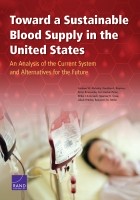| 来源类型 | Research Reports
|
| 规范类型 | 报告
|
| DOI | https://doi.org/10.7249/RR1575
|
| ISBN | 9780833096791
|
| 来源ID | RR-1575-DHHS
|
| Toward a Sustainable Blood Supply in the United States: An Analysis of the Current System and Alternatives for the Future |
| Andrew W. Mulcahy; Kandice A. Kapinos; Brian Briscombe; Lori Uscher-Pines; Ritika Chaturvedi; Spencer R. Case; Jakub P. Hlavka; Benjamin M. Miller
|
| 发表日期 | 2016
|
| 出版年 | 2016
|
| 页码 | 216
|
| 语种 | 英语
|
| 结论 |
Overarching Findings- The U.S. blood system under the status quo operates effectively and, in many cases, efficiently.
- The U.S. blood system is in a period of flux and uncertainty.
- There are unlikely but possible scenarios in which the supply of blood would be disrupted.
Threats to Sustainability- The current system is not conducive to private investments in innovation.
- Suppliers to blood centers face significant uncertainty and contribute to concerns about sustainability.
- Services provided by local blood banks may be at risk.
Opportunities to Improve Sustainability- Stakeholders want support in making technology adoption decisions.
- Blood center stakeholders are contemplating different market structures for the future.
- All stakeholders recognize the important role of blood as a public health good.
|
| 摘要 |
- Collect data on blood use and financial arrangements: Stakeholders have access to statistics on blood use and transactions tied to their individual organizations, but the U.S. government does not have access to comprehensive data describing the performance of the blood system.
- Develop and disseminate a vision for appropriate levels of surge capacity: Describing a desired level of surge capacity from a public health and preparedness perspective will help stakeholders and policymakers plan and estimate the costs associated with maintaining surge capacity.
- Subsidize blood centers' ability to maintain surge capacity: Surge capacity to respond to serious events and emergencies falls outside the typical financial arrangements between hospitals and blood centers, so there is an argument that the government should separately finance this surge capacity.
- Build relationships with brokers and other entities to form a blood "safety net": A well-established set of relationships can reduce emergency response times.
- Build and implement a value framework for new technology: We recommend that HHS invest in health technology assessment research for existing technologies with low adoption rates and for technologies on the horizon.
- Pay directly for new technologies in which there is no private business case for adoption: Technologies often have clear public health and preparedness benefits. In these cases, U.S. government financing of technology acquisition costs might be appropriate.
- Implement emergency use authorization and contingency planning for key supplies and inputs: The FDA could implement emergency use authorizations for replacement supplies and other inputs in the event of a shortage.
|
| 主题 | Emergency Preparedness
; Health Care Services Capacity
; Health Screening
; Public Health Preparedness
; United States
|
| URL | https://www.rand.org/pubs/research_reports/RR1575.html
|
| 来源智库 | RAND Corporation (United States)
|
| 引用统计 |
|
| 资源类型 | 智库出版物
|
| 条目标识符 | http://119.78.100.153/handle/2XGU8XDN/108267
|
推荐引用方式
GB/T 7714 |
Andrew W. Mulcahy,Kandice A. Kapinos,Brian Briscombe,et al. Toward a Sustainable Blood Supply in the United States: An Analysis of the Current System and Alternatives for the Future. 2016.
|
|
文件名:
|
x1495316241767.jpg
|
|
格式:
|
JPEG
|

|
文件名:
|
RAND_RR1575.pdf
|
|
格式:
|
Adobe PDF
|
除非特别说明,本系统中所有内容都受版权保护,并保留所有权利。